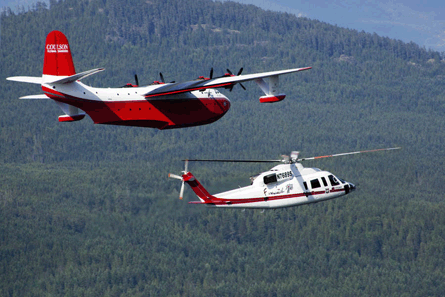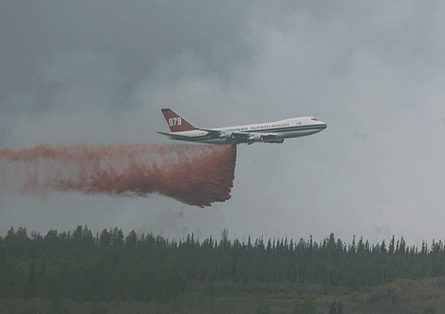All eyes are on the USA this summer as state and federal agencies experiment with the nascent very-large air tanker (VLAT) fleet, a development that has nations from Australia to Europe watching with interest to see how this relatively new option for aerial firefighting pans out.
Front and centre in the debate are the VLATs under contract with the state of California and under consideration by the US Forest Service (USFS), the main firefighting arm for fixed-wing aircraft in the government.
There are three such aircraft in service - two 45,500 litre (12,000USgal) converted McDonnell Douglas DC-10s owned by California-based 10 Tanker Air Carrier, and a 75,800 litre converted Boeing 747-100 owned by Evergreen International Aviation, based in Oregon.
 |
|---|
© 10 Air Tanker Center |
California has all three aircraft on as-needed contracts this year and has been fighting fires with the two DC-10s as recently as mid-August. The VLATs are generally used as "second alarm" responders, officials say, used to create break lines for fires that survive an initial attack by other means.
Recent studies in Australia suggested similar uses, finding that VLATs are at a cost disadvantage for first attack when fires are small and where water drop accuracy is required.
Debate continues in the USA over the need or best use of VLATs despite the reality that many of the workhorses of legacy large tanker fleets, the so-called Type 1 and Type 2 tankers that carry from 6,800 litres to just under 41,700 litres, have been removed from the fleet due to age and airworthiness concerns. VLATS by definition carry 41,700 litres or more.
According to Tom Harbour, director of the USFS's fire and aviation division, the agency this year has 19 large air tankers (Lockheed P2V Neptunes and P-3 Orions) under contract, down from 44 aircraft in 2002, before several high-profile structural failure accidents brought the fleet under scrutiny. "Those form the bulk of the large air tanker fleet. They are assisted by helicopters and single-engined air tankers contracted by Department of Interior partners," Harbour says.
"We believe that VLATs are going to be useful tools in addition to the regular fleet, but we still believe our bread and butter is going to be in the 2,500USgal to 4,000-5,000USgal capacity aircraft that are multipurpose large air tankers," he adds.
Harbour's assessment in part comes from a March 2009 report on VLATs by NASA. Along with reviewing the airworthiness of VLATs, the USFS asked NASA researchers to determine the compatibility of the tankers with the agency's retardant delivery mission and to develop recommended operational procedures.
 |
|---|
© Coulson Flying Tankers |
While finding that the DC-10 and 747 met airworthiness requirements for the modified aircraft and retardant delivery systems, NASA was reserved in its finding of compatibility: "It was concluded that VLAT aircraft are probably compatible with the wildland fire suppression mission, provided that they are used to supplement other aerial retardant delivery platforms rather than replace them in all environments."
One of NASA's concerns, flushed out in simulator sessions with pilots, was that steep or rugged terrain, reduced visibility due to smoke and ash, and irregularly shaped drop zones will impact the VLATs more than other tanker platforms due to size-related manoeuvrability issues. As a result, NASA recommended that VLATs fly at 300ft (90m) or more above the ground for level or gently rolling terrain and 400ft or more in steep or rugged conditions.
Experience in the USA with VLATs is largely limited to the California Department of Forestry and Fire Protection's (Cal Fire) use of 10 Tanker's two DC-10s. Rick Hatton, managing partner for 10 Tanker, says the company has completed more than 265 missions during 35 fires in California and Washington since 2006.
The company flew 26 mission under a provisional status and was awarded a three-year contract on an exclusive use basis, meaning the aircraft would have to be ready for flight 30min after being called. California, due to budget issues, recently placed the aircraft on as-needed contracts, which requires 24h notice and a minimum use of five days for the DC-10 and 10 days for the 747 and risks the aircraft being otherwise committed.
Bill Payne, the senior aviation officer at Cal Fire, says that the two aircraft had flown six missions during mid-August wildfires in the state, but could often not fly due to having less than 5.5km (3nm) visibility at the sites, the minimum required for visual flight rules.
A fully loaded DC-10 tanker can lay out a line of retardant 1.4km long, creating an "artificial river" that blocks the advance of the fire, or can be used to drop partial loads using its constant-flow, gravity assist system.
Modifications to the basic aircraft, completed by Victorville Aerospace and Kalitta Air, take 15,000 man-hours and include airframe strengthening needed to incorporate the external retardant tank, built by Oregon-based Jordan Air. The final product has a US Federal Aviation Administration standard airworthiness certificate, as does Evergreen's 747 tanker. Hatton says 10 Tanker has all the materials and paperwork complete to build a third tanker.
Cal Fire also has the Evergreen 747 tanker on as-needed contract. The agency tested the aircraft in May, but has not yet used it.
Sam White, Evergreen's senior vice-president, says the tanker recently finished a demonstration tour in France, Germany, Spain and Edmonton in Canada, and that officials were headed to Australia for talks in late August. While in Canada, White says the state of Alaska asked for a demonstration, which resulted in two air drops on a remote fire in Fairbanks, which it successfully accomplished with loads that were mostly water and small amounts of retardant. The aircraft is signed to as-needed contracts with California and Alaska. "We're ready to go," says White.
 |
|---|
© Evergreen International Aviation |
Rather than a constant flow release, the Supertanker uses a pressurisation system that White says allows for drops at altitudes significantly higher than 200ft above the ground, the typical drop altitude for gravity systems.
The modified 747-100 blasts the internally held fluids through four nozzles on the underside-rear of the fuselage, generating the equivalent thrust of a 50,000lb (223kN) engine.
"We went to a pressurised system primarily because we want to fight fires at night," says White. "Our concept is to clobber the fire when it's dormant at night. How can you do that safely? You need to fly at a higher altitude."
Cal Fire is not keen on trying out that yet. "We're not going to do night drops," says Payne. "It's 50% more dangerous at night. You try to manoeuvre in uneven terrain at night based on GPS and terrain avoidance - the risk is far too great." Instead Cal Fire uses helicopters with night vision goggle-equipped crews for night operations when there is a "significant threat to property and life", he says.
Ultimately, Payne say California will ideally have one VLAT on an exclusive-use contract and two on as-needed contracts. He would also like to see the USFS have two VLATs on exclusive-use contracts positioned strategically for the fire seasons.
The USFS is gaining experience with larger aircraft through a 153-day exclusive use contract for a 27,300 litre Martin Mars scooper tanker belonging to Canada-based Coulson Flying Tankers. In addition to a large load of water that is injected with a gel that makes a fluid that acts like a wet blanket to smother fire, the aircraft comes with a Sikorsky S-76 chase helicopter that has thermal and colour video cameras as well as other data acquisition systems.
Chief executive Wayne Coulson says that the idea was to record "all the variables that people could use to make data believable". While in the flight, the S-76 can send data to the ground for fire forecasters.
USFS's Harbour says the agency continues to analyse what might be the ideal mix of aircraft. "I think we're headed to a place where we'd like the see a few more large air tankers, but we've not set our sights just yet on specific numbers," he says. "We're moving as quickly as we can because these P-3s and P2Vs are running out of time. A year from now we would like to have a pretty clear picture."
Source: Flight International



















